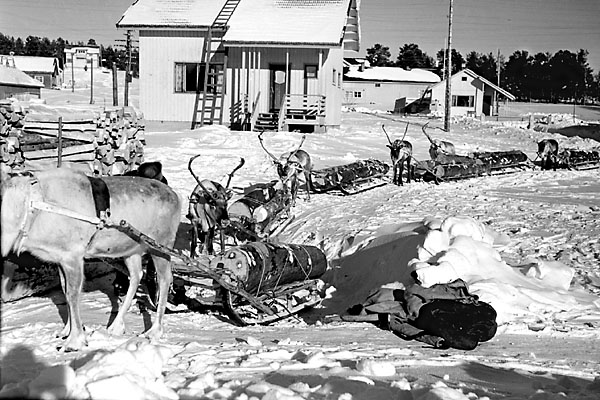Ráidu (raito, fi.), a row of Saami sleds with reindeer harnessed in front of them
Ráidu (raito)
Poro on ollut saamelaisten pääasiallisin kulkuväline talvisin etenkin, jos mukana on täytynyt kuljettaa myös tavaroita. Useita poroja on voitu silloin sitoa toisiinsa peräkkäin siten, että jäljessä kulkevan poron hihna on sidottu edellä käyvän ahkioon. Näin muodostuvaa porojonoa ahkioineen kutsutaan pohjoissaamessa nimellä ráidu, raito. Täydessä raidossa on 10-12 ahkiota. Viimeisenä on ahkiotta poro tai pari, joiden tehtävänä on pidätellä edellä kulkevia ahkioita kasautumasta mäissä liian lähelle toisiaan.
Pohjoissaamen sanalla ráidu on pororaitoa tarkoittava vastine myös muissa saamelaiskielissä. Ainakin pohjois- ja luulajansaamessa sana merkitsee lisäksi muunkinlaista jonoa tai riviä taikka sarjaa peräkkäisiä esineitä tai tapahtumia.
Ráidu kuuluu saamelaiskielten skandinaavisiin lainoihin. Se lienee lainattu kieleen jo kantaskandinaavisesta kielimuodosta. Lähtökohdaksi on esitetty pariakin kantaskandinaavista muotoa. Toinen näistä on *raiđo* (josta on peräisin mm. muinaisnorjan rei? 'matkanteko, matka, ratsastus'), joka on johdos verbistä *ri*đan ja jonka jatkaja on esimerkiksi nykyruotsin rida 'ratsastaa'. Toinen mahdollinen lähtökohta on *skrai?o*, josta johtuu esimerkiksi nykyruotsin verbi skrida 'kulkea, astella'. Samaa lähtöä on myös ruotsin Yläkainuun murteen vanha sana skraj, joka on merkitykseltään täysin identtinen pohjoissaamen ráidu-sanan kanssa.
Saamelaiskielistä ráidu vastineineen on lainautunut edelleen naapurikieliin ruotsiin, norjaan, suomeen, karjalaan ja venäjään, jonne se on voinut kulkeutua myös karjalan välityksellä.
Sisällysluettelo: Elinkeinot ja liikkuminen
Ráidu (raito, fi.), a row of Saami sleds with reindeer harnessed in front of them
The sledge was the Saamis main means of transport, particularly in winter if they had a lot of goods to carry with them. In such a case, it was possible to harness several reindeer one behind the other so that the trace of the following reindeer was attached to the sledge in front. A line of reindeer-drawn sledges attached in this way was called ráidu in North Saami. A full line consisted of 10-12 sledges. Last in the line were one or two reindeer that were not drawing a sledge. Their purpose was to prevent the sledges in front from piling up too closely together. There are corresponding forms with the same meaning in other Saami languages. The word is probably a borrowing from Proto-Scandinavian. At least in North and Lule Saami the word also means some other kind of line or row or a series of objects or events.
Ráidu is then a Scandinavian loan word. It was probably borrowed into Saami in its Proto-Scandinavian form. Two Proto-Scandinavian forms have in fact been proposed as its source. One is *raiđō (from which the Old Norwegian reiœ travel, journey, riding is descended), a derivation from the verb *riđan, which has developed into the modern Swedish rida to ride for example). The other possible source is *skraiœō, from which the modern Swedish skrida to go, proceed comes. Of the same origin is an old Swedish dialect word from the Yläkainuu region skraj, which has exactly the same meaning as the North Saami raidu.
The Saami word ráidu has been borrowed on into neighbouring languages: Swedish, Norwegian, Swedish, Karelian and Russian. It may also have passed into the latter through Karelian.
